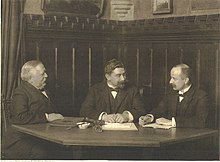Eduard Hallier
Eduard Hallier (born March 23, 1866 in Hamburg ; † October 2, 1959 there ) was a German lawyer . He is considered to be the initiator of a public library in Hamburg, today's Hamburg public library .
Live and act
Eduard Hallier was the only son of an architect of the same name who had taken part in the planning of the coffee flaps and died in 1889. Hallier grew up with a secure financial situation, attended a secondary school and the Johanneum's school for scholars . From 1886 to 1890 he studied law at universities in Freiburg , Munich , Leipzig and Berlin . After graduating in July 1890 in Berlin, he received his doctorate in Göttingen in the same year. Hallier traveled the world from August 1890 to August 1891 and then completed a legal clerkship from 1891 to 1894. In December 1894 he passed the assessor exam and at the end of 1894 began working as a lawyer in Hamburg. Together with his school friend Georg Blohm, he founded his own law firm in February 1895.
In addition to his work as a lawyer, Hallier was involved in numerous associations, charitable institutions and in the church. Through his travels, especially through North America and Great Britain , he became known to public lending libraries. Hallier campaigned for the establishment of such halls in Hamburg. He succeeded in convincing the Patriotic Society of 1765 , of which he had been a member since 1897, and, together with it, the Senate of the Free and Hanseatic City of Hamburg of this idea. After the Senate made a bar available, Hamburg's first public library opened on October 2, 1899.
As chairman of the Patriotic Society, Hallier participated in the founding of the private charity Hamburgische Kriegshilfe in August 1914 . The lawyer worked in a leading position in the war kitchens that served hot meals to the residents of the Hanseatic city during the First World War . Hallier had been a member of the church council of Sankt Katharinenkirche since 1929 and joined the German Christians in the election of the board in 1933 . After being elected as community elder in 1935, he was a member of the senior elders' college . Hallier was also an extraordinary member of the Hamburg Artists' Association from 1832 .
Hallier, who had been a member of the Pan-German Association since 1897 , was considered politically extremely conservative. During the Weimar period he was a member of the German People's Party (DVP) and, since May 1, 1933, of the NSDAP . Hallier himself expressed himself contradicting this. He stated either that he had become a member of the NSDAP out of conviction or unknowingly because he was a member of the DVP.
In a denazification process after the end of the Second World War in 1947, Hallier was classified as a category III minor, which resulted in the loss of his license to practice law. Hallier appealed in the same year and was now considered to be a follower of category IV. In 1949, another examination took place, after which he was considered exonerated. He resigned from the position of elder of the Patriotic Society in 1949. Two years later, Hallier left the management of the Hamburg library, not of his own free will.
Eduard Hallier died in October 1959 in his hometown. He was buried in the area of the family grave in the Ohlsdorf cemetery , grid square T 20 / T21 ( Kapellenstrasse southwest of Chapel 2).
literature
- Sigrid Schambach: Hallier, Eduard . In: Franklin Kopitzsch, Dirk Brietzke (Hrsg.): Hamburgische Biographie . tape 4 . Wallstein, Göttingen 2008, ISBN 978-3-8353-0229-7 , pp. 129-130 .
Individual evidence
- ↑ Each only one book! , taz.de of October 1, 1999
| personal data | |
|---|---|
| SURNAME | Hallier, Eduard |
| BRIEF DESCRIPTION | German lawyer |
| DATE OF BIRTH | March 23, 1866 |
| PLACE OF BIRTH | Hamburg |
| DATE OF DEATH | October 2, 1959 |
| Place of death | Hamburg |

